The TNREGINET Portal, developed by the Tamil Nadu Registration Department, is a user-friendly online platform designed to streamline property-related and registration services for residents of Tamil Nadu. It eliminates the need for physical visits to government offices, offering transparency, efficiency, and accessibility.
One of its key features is TNREGINET EC View, which allows users to easily access and view the Encumbrance Certificate (EC) online. This digital facility helps verify property ownership history, ensuring secure property transactions and reducing fraud, while providing a convenient, paperless service to the public.

What is TNREGINET?
TNREGINET is the official online portal launched by the Tamil Nadu Registration and Stamps Department. This digital platform provides citizens with easy access to services like property registration, encumbrance certificate (EC) search, document verification, and stamp duty payment. By bringing these services online, the government aims to increase transparency, reduce paperwork, and save time for property owners and buyers.
Instead of visiting registration offices and standing in long queues, users can now handle multiple property-related tasks conveniently from their home.
How to Register for the TNREGINET Portal?
To access TNREGINET Portal services, you must first create an account. Follow these simple steps:
1. Visit the official website:➔ https://tnreginet.gov.in
2. On the homepage, click Registration > User Registration.
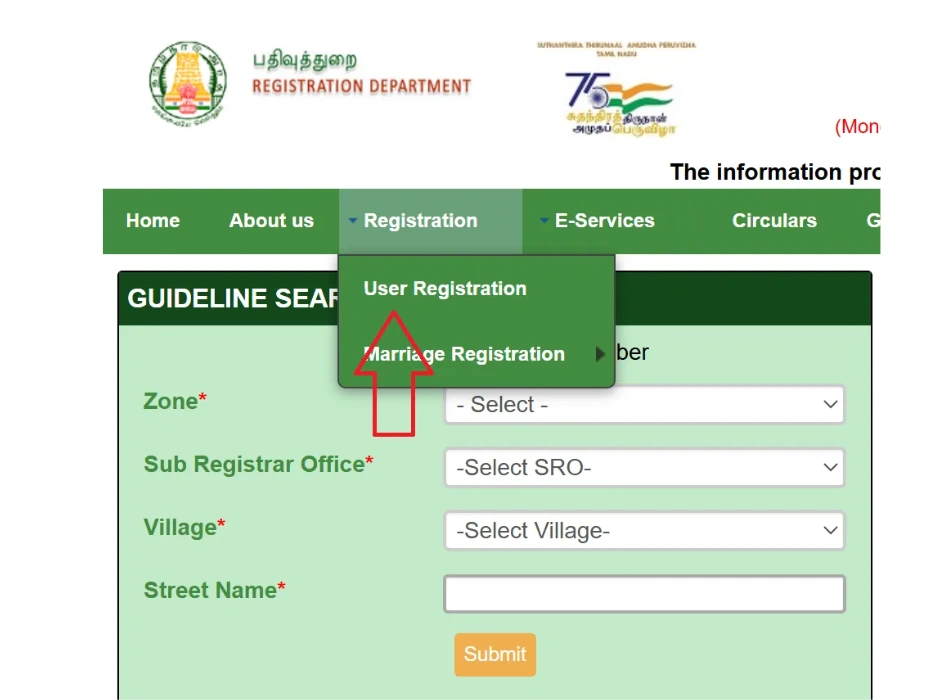
3. Select the appropriate User Type (e.g., Citizen, Document Writer, Builder).
4. Fill in the required details:
- Username
- Password
- Security Question
- Full Name
- Email Address
- Mobile Number
- ID Proof
- Submit the registration form.
- Verify your account by entering the OTP sent to your email or mobile number.
- Log in using your verified credentials to access TNREGINET services.
| Important Notes: You must use the portal within 7 days of registration, or your account will be deactivated.To keep your account active, log in at least once every 3 months. |
Encumbrance Certificate (EC) View Online on TNREGINET
An EC confirms a property’s legal and financial status.
1. Log in to the TNREGINET Portal: https://tnreginet.gov.in
2. Navigate to: E-Services > Encumbrance Certificate (EC) > View EC
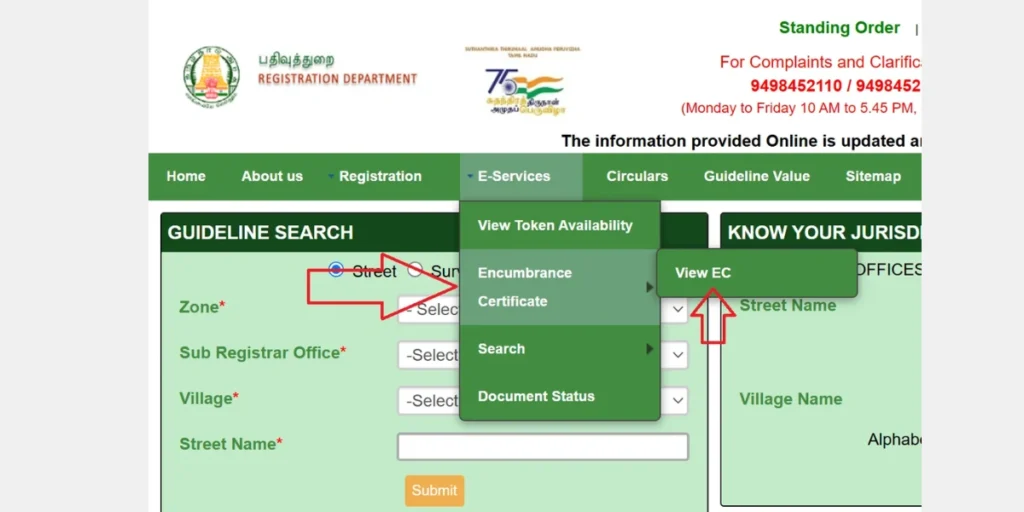
3. Choose the Search Type: EC, Document-wise, or Plot Flat-wise.
4. For EC Search:
5. Enter the following details:
- Zone
- District
- Sub-Registrar Office (SRO)
- EC Start Date & End Date
- Village
- Survey Number
- Subdivision Number
6. For Document-wise Search: Enter: Document Number, Year of Registration, Sub-Registrar Office (SRO)
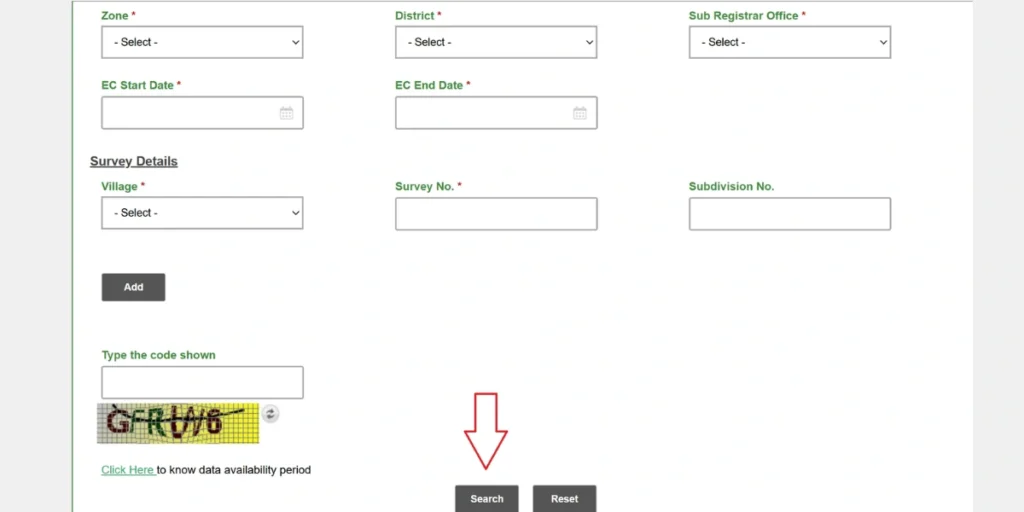
7. Enter the Captcha Code and click Search.
- The TNREGINET Encumbrance Certificate (EC) will appear on-screen, and download it as a PDF for free.
Property Registration on TNREGINET Portal
- Log in to the TNREGINET Portal: https://tnreginet.gov.in
- Go to: Create Application > Create Document
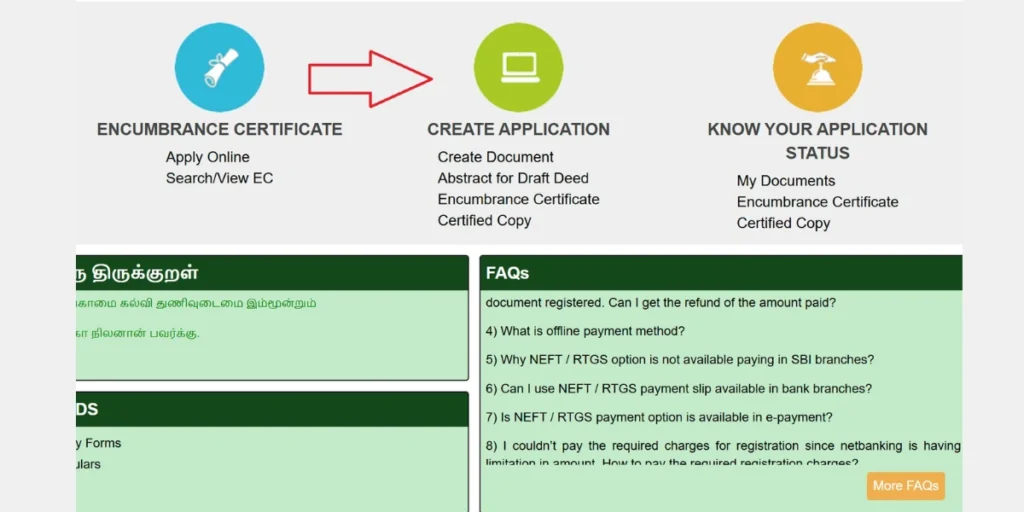
- Select the Document Type: Sale Deed, Mortgage, and other relevant types
- Enter the Property Details:(Location, Survey Number, Other relevant property information) and provide details of the Parties Involved: (Buyer, Seller)
- Upload Required Documents: Sale Agreement, ID Proofs of parties
- Use the portal’s Stamp Duty Calculator to compute the applicable stamp duty and pay it online.
- Schedule an Appointment with the Sub-Registrar Office (SRO) for document verification.
- Submit the Application and save the generated Reference Number for future tracking.
- Visit the Sub-Registrar Office (SRO) on the scheduled appointment date for final verification and completion of registration.
Check TNREGINET Guideline Value
TNREGINET Guideline Value is the minimum property registration value set by the government of Tamil Nadu to calculate stamp duty and registration charges.
- Visit the official portal: https://tnreginet.gov.in
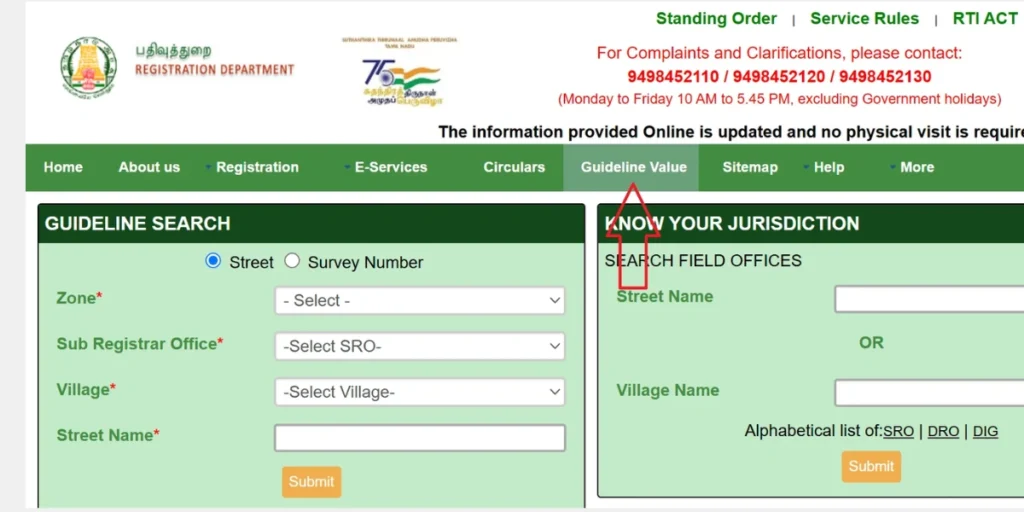
- Click on Guideline Value on the homepage.
- Select the Date Range: For the latest values, choose a date range (e.g., from 08-09-2025).
- Enter the following details: Region, Sub-Registrar Office (SRO), Registration Village, Street Name or Survey Number, Land Classification
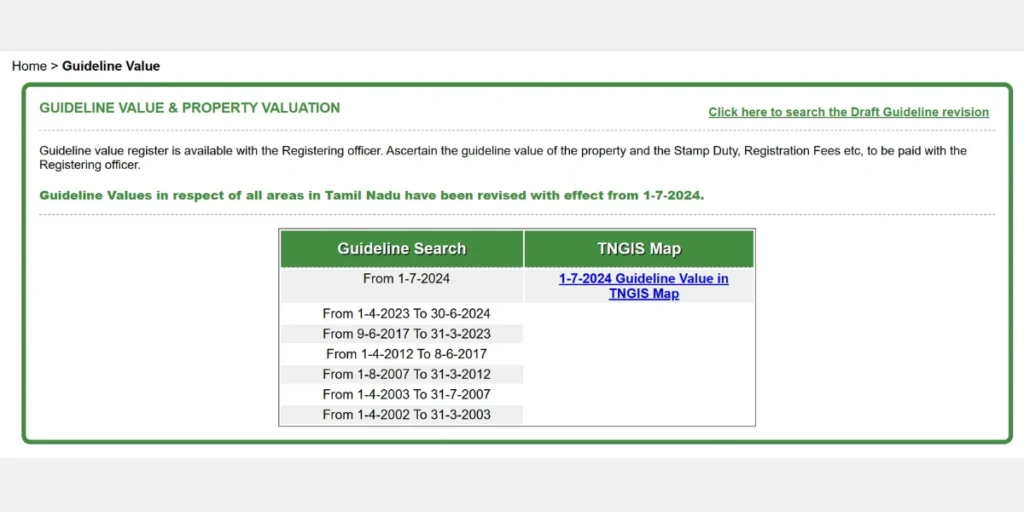
- Click Search to view the TNREGINET Guideline Value applicable for the specified property.
- Use this value to accurately calculate the Stamp Duty and Registration Fees during property registration.
| Important Note: The guideline value is essential to ensure fair property transactions and avoid undervaluation. |
Download and Document Search
- Click the TNREGINET Login button: https://tnreginet.gov.in
- Navigate to: E-Services > Document Search
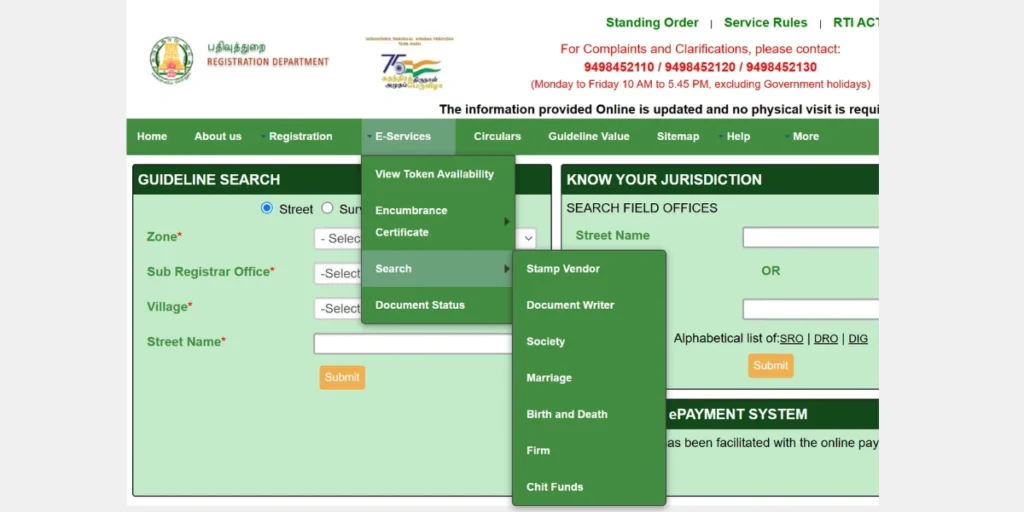
- Enter the necessary details: Document Number, Party Names (Buyer, Seller), Property Details (Survey Number, Location, etc.)
- Click Search to TNREGINET EC to view the registered document.
- Download the document as needed in PDF format for your records.
Birth, Marriage, and Death Registration
- Log in to the TNREGINET Portal: https://tnreginet.gov.in
- Go to: Create Application > Create Document
- Select the Certificate Type: Marriage Certificate, Birth Certificate, Death Certificate
- Fill in the Required Details: Personal Information (Names, Dates, Places, etc.), Upload Supporting Documents: Marriage Proof, Birth Certificate, Death Certificate
- Apply and save the Reference Number.
- Track the TNREGINET application status anytime using the reference number.
Key Services Available on TNREGINET Portal
The official TNREGINET Portal (https://tnreginet.gov.in) provides several important services to make property and civil registration processes easier and more efficient for the public. These key services include:
- Encumbrance Certificate (EC) View
- Document Registration (Sale Deed, Mortgage, Gift Deed, etc.)
- Marriage Registration
- Birth and Death Certificate Services
- Chit Fund Registration
- Firm and Society Registration
- Stamp Duty Calculation Tool
- Online Appointment Booking for Sub-Registrar Office visits
One of the most popular features of the portal is the EC View Online Service for Tamil Nadu, which allows users to instantly view and download the Encumbrance Certificate (EC) online. This service helps property owners and buyers verify property transaction history in a simple and paperless way.
How to Check Jurisdiction
To locate the Sub-Registrar Office (SRO) for a property:
- Visit and log in to the TNREGINET portal.
- On the homepage, find and click the KNOW YOUR JURISDICTION section.
- Enter the required property details such as the registration number, district, and survey number.
- Click Search to display the name and contact information of the relevant Sub-Registrar Office.
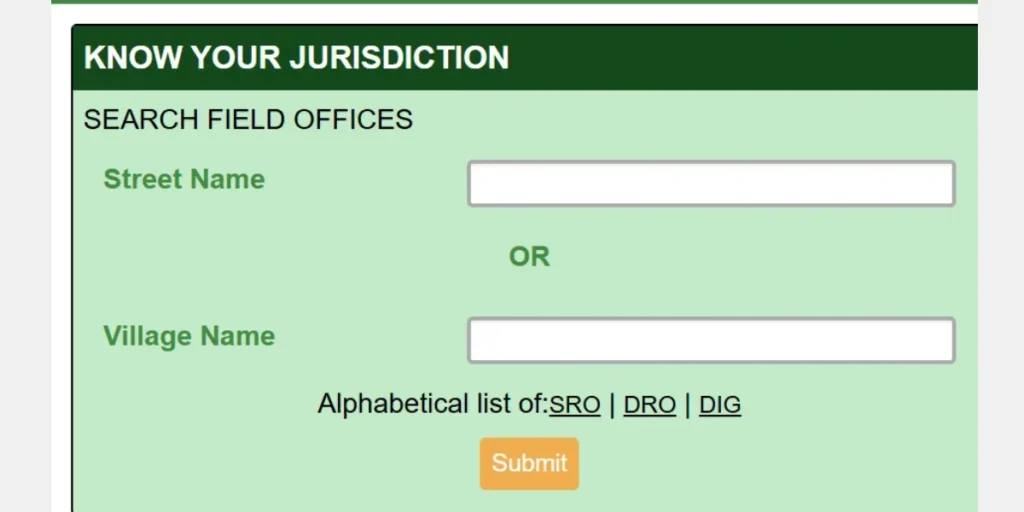
How to Calculate Building Value
- Log in to the TNREGINET portal.
- Select Calculate Building Value from the homepage.
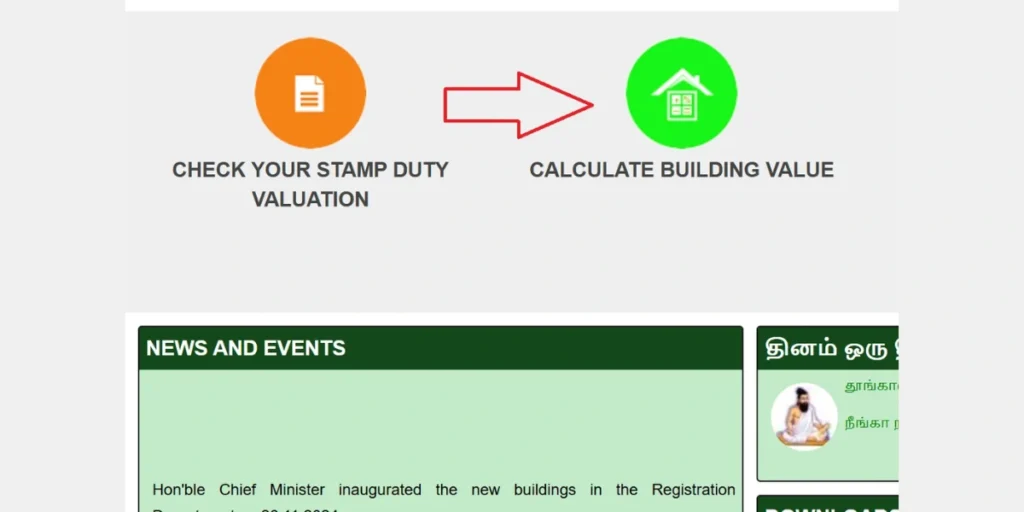
- Fill in the required details, including building location, size, age, and available amenities (such as roof type and number of rooms).
- Click Search to see the estimated value of the building.
Services Offered by TNREGINET
Complete List of Services Available on TNREGINET Portal
TNREGINET offers a comprehensive range of services for registration and certification needs of Tamil Nadu residents:
Property Registration: Enables online submission of property documents, payment of stamp duty, and appointment booking at Sub-Registrar Offices (SROs).
Encumbrance Certificate (EC): Provides legal and financial status details of a property, which are essential during property transactions.
Guideline Value Search: Assists in determining stamp duty and registration fees based on government-prescribed property values.
Document Search and Download: Allows users to search and download historical property records or certified copies of registered documents.
Stamp Duty Payment: Facilitates online calculation and payment of stamp duty for various document registrations.
Marriage, Birth, and Death Registration: Apply for certificates online without the need to visit government offices.
Jurisdiction Search: Helps identify the correct Sub-Registrar Office (SRO) for a specific property.
Building Value Calculation: Estimates the property’s value for registration purposes according to government guidelines.
Other Registrations: Supports online registration of firms, societies, chit funds, and other legal entities
Key Features of TNREGINET EC Portal
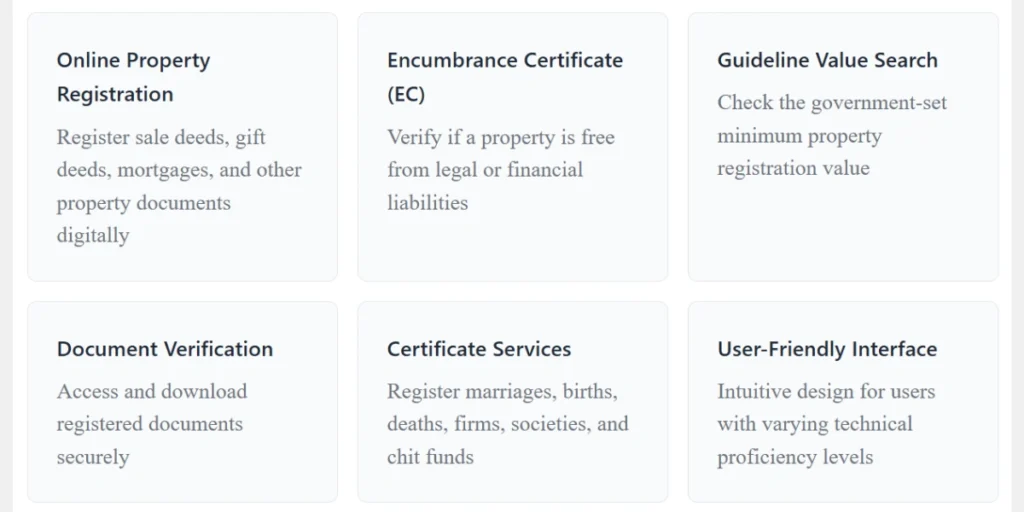
Key Benefits

What is an Encumbrance Certificate (EC)?
An Encumbrance Certificate (EC) is an important legal document that records all registered transactions related to a property. It serves as proof of ownership and confirms that the property is free from any legal or financial liabilities, such as loans, mortgages, or disputes.
Using the TN EC View Online service, you can easily access the property’s transaction history from anywhere, without the need to visit government offices.
FAQ
1. What is TNREGINET?
TNREGINET is an online portal provided by the Government of Tamil Nadu for property registration, certificate issuance, and other related services. It helps residents complete various registration tasks and access important documents online.
2. How can I register a property using TNREGINET?
To register a property, visit the TNREGINET portal, log in with your credentials, upload the required property documents, pay the applicable stamp duty online, and schedule an appointment at the Sub-Registrar Office (SRO).
3. Can I check the Encumbrance Certificate (EC) online through TNREGINET?
Yes, TNREGINET offers the EC View Online service, where you can check and download the Encumbrance Certificate by entering property details like registration number, district, and survey number.
4. Is it possible to calculate stamp duty on the TNREGINET Portal?
Yes, the portal provides a Stamp Duty Calculator where you can enter property details to calculate the exact stamp duty payable before proceeding with registration.
5. How do I find the Sub-Registrar Office (SRO) jurisdiction in TNREGINET?
Use the Know Your Jurisdiction feature on the TNREGINET homepage. Enter the property details such as registration number, district, or survey number, and the portal will display the appropriate SRO’s name and contact details.
6. Can I register marriage, birth, and death certificates online using the TNREGINET Portal?
Yes, TNREGINET allows online application for marriage, birth, and death certificate registration, eliminating the need to visit government offices in person.